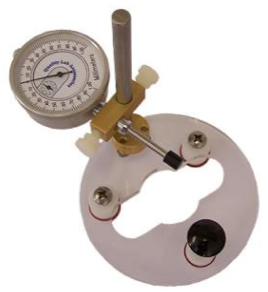
BE THE FIRST TO KNOW
Enter your email below to subscribe to the QLA newsletter to receive timely updates from your favorites products.
USP Toolkit: ± 0.5oC but all vessels should agree within 0.4oC
ASTM: ± 0.5oC
USP Toolkit: ≤1.0 mm runout at bottom of basket
ASTM ≤1.0 mm runout at bottom of basket
Wobble is the movement from the centre line of a shaft or basket as it rotates. This causes a disruption in the flow profile in the vessel and can have a significant impact on dissolution rate.
The measurement is made on the basket or paddle shaft close to the paddle blade or basket position. For basket tests, an additional measurement is made at the rim of the basket.

Measurements are performed using a wobble meter. This requires a rigid support and the easiest type to use or those with a support that sits in the vessel itself.
Place the measurement tip on the shaft at the appropriate position and rotate the shaft slowly. This will probably require that the shaft is lifted and rotated out of the vessel with most testers. The 'runout' reading is the total displacement on the dial gauge in mm.
The potential for wobble is worse on longer shafts than shorter ones. It makes sense to store shafts properly in a shaft rack rather than in a lab drawer where they can become damaged and scratched.
A quick and simple way to just whether a shaft is straight or not is run it along the edge of a bench and any deformity will be immediately obvious by eye. Not very scientific of course but a useful guide. In general, if you can see a deformity as a shaft is rotating then there is a reasonable chance it will be out of specification.
Basket wobble presents a far larger problem and is a frequent cause of failure. The measurement is on the edge of the basket rim, and even if the shaft is perfect, the basket will have another set of readings.
Failures are most commonly due to incorrect handling of the baskets themselves, or bent and corroded clips on the basket shaft.
If shaft clips are bent or rusty and cannot be replaced then the shaft may need to be replaced as a complete unit. Some shafts have replaceable clips and it makes sense to replace any with that style.